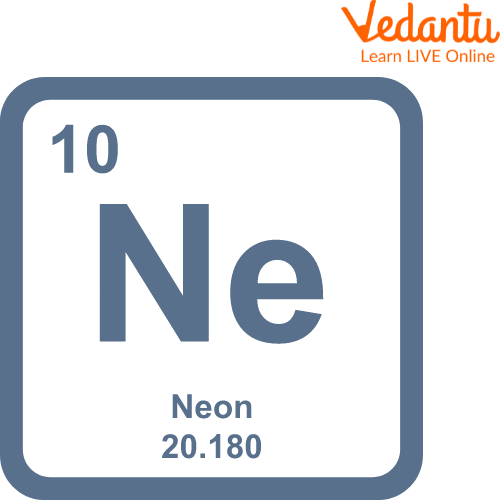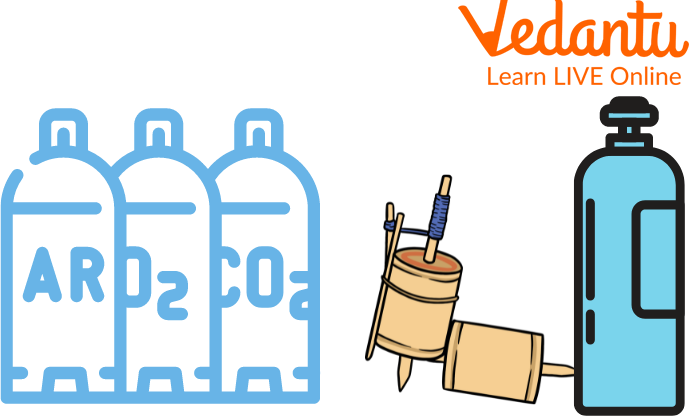




Why Neon Matters: Properties, Discovery & Everyday Applications
While walking on the roads, have you ever seen the beautiful, colourful advertisement signs which are blooming with beautiful lightning on the road? So those beautiful signs are neon, a noble gas used in advertisement signs. Neon is used in our everyday appliances also like television tubes, vacuums, lasers and in many other things.
It's a very normal gas which is not very exciting without electricity. So in this article, we will learn about what is neon used for, some chemical properties of neon and some of its interesting facts. So without wasting more time let's learn more about neon.
What is Neon?
Neon is a type of gas which does not react with anything. It is a chemical element whose atomic number is 10. Given below is a neon element image.

Neon
Neon was discovered in 1898 and it was one of the three residual rare inert elements which remained in dry air after nitrogen, oxygen, argon and carbon dioxide were removed. Neon was the second of the three rare gases. The name neon is derived from the Greek word "neuter" meaning 'new'. Also, its symbol is Ne.
History of Neon

History of Neon
So, neon was discovered in 1898 by two British chemists whose names were Sir William Ramsay and Morris W. Travers. They discovered it as a component of the most volatile fraction of liquefied crude argon which is obtained from air. It was immediately recognised as a new element by its unique glow when it was electrically stimulated. The name neon is derived from the Greek word neos, which means “new.”
Under low pressure, neon emits a bright orange-red light when an electrical current is passed through it. This property is utilised in neon signs, in some fluorescent and gaseous conduction lamps, and in high-voltage testers. And in that, no stable chemical compounds of it have been observed.
Chemical Properties of Neon
Neon, is a chemical element, inert gas of Group 18 (noble gases) of the periodic table, which is used in electric signs and fluorescent lamps.
Neon is colourless, odourless (has no smell), it is tasteless and lighter than the air, neon gas occurs in minute quantities in the earth’s atmosphere and is trapped within the rocks of the Earth’s crust.
Its only commercial source is the atmosphere, which is 18 parts per million by volume. Itts boiling point temperature is −246 °C (−411 °F).
It remains along with helium and hydrogen, in the small fraction of the air that resists liquefaction upon cooling to −195.8 °C (−320.4 °F, the boiling point of liquid nitrogen).
Neon is isolated from a cold, gaseous mixture by bringing it to contact with activated charcoal, which adsorbs the neon and hydrogen; then removal of hydrogen is affected by adding enough oxygen to convert it all to the water, which along with any surplus oxygen, condenses upon cooling. Processing 88,000 pounds of liquid air will produce only one pound of neon.
Facts About Neon
Some interesting facts about neon are as follows:
One of the lesser known neon facts is that REDDISH-ORANGE is the Real neon light because when you fill a clear tube with pure neon gas, it lights up a reddish-orange in colour.
Neon gas is very rare. A rare gas is another name for a noble gas. These six gases form approximately only 1% of the earth’s atmosphere.
Georges Claude displayed his neon lamps at a Paris exhibition, and it was the first neon light that was revealed in 1910.
In January 2017, a neon sign was once sold for 48,300 at an auction night in Maine, USA, the sign was from the legendary Los Angeles rock club, ‘Whisky a Go Go' and it was 13ft long.
Neon lighting is a handmade beautiful art and creators use blow torches to heat glass tubes before bending them into place and sealing them all together.
Uses of Neon

Neon Element
Having unique properties of neon means that neon has many uses in everyday life. Let's discuss some of them. It'sIt's used in advertising signs, vacuum tubes, wave metre tubes, lighting arrestors, television tubes, plasma tubes and helium-neon lasers.
Nowadays liquid neon is commercially available and is used as a cryogenic refrigerant. Neon is often used for producing unmistakable bright reddish-orange light. Although tube lights with other colours are often called "neon", they use different noble gases and varied colours of fluorescent lighting.
Summary
In this article, we have learned many wonderful things about neon. We learnt about what it is, how we use it in our everyday life, and what was the history of neon. Moreover, we learnt the chemical properties of neon and we also discussed some wonderful interesting facts which were related to neon. We have discussed the use of neon and how beautifully the advertisement signs are made; they look so eye-catching isn't it? We also discussed that without electricity neon is not an enjoyable element. We hope you enjoyed reading this article.
FAQs on Essential Facts About Neon
1. What are some interesting facts about the element neon?
Neon is a fascinating element with several unique characteristics. Here are a few key facts:
It is the fifth most abundant chemical element in the universe, but it is quite rare on Earth.
The name 'neon' comes from the Greek word “neos,” which means “new.”
Despite its fame in lighting, it is a colourless, odourless, and tasteless gas in its natural state.
Neon is a noble gas, which means it is chemically inert and does not easily form compounds with other elements.
2. What makes neon glow with its signature reddish-orange colour?
Neon gas glows because of a process involving its electrons. When a high electrical voltage is passed through a sealed glass tube containing neon gas, the energy excites the neon atoms' electrons, causing them to jump to a higher energy level. As these electrons immediately fall back to their original, stable level, they release the extra energy in the form of light. For neon, this light is characteristically a bright reddish-orange colour.
3. What are the main uses of neon gas?
While most famous for its use in advertising signs, neon has several other important applications. Its primary uses include:
Illuminated Signs: Creating bright, eye-catching advertising and decorative signs.
High-Voltage Indicators: Used in devices to show that high voltage is present.
Lightning Arresters: To protect electrical equipment from power surges.
Cryogenics: Liquid neon is used as an economical cryogenic refrigerant in certain applications.
4. Is neon gas dangerous or flammable?
No, neon gas itself is not dangerous, toxic, or flammable. As a noble gas, it is chemically inert and does not react or burn. However, there are two potential risks associated with its use. Firstly, in a poorly ventilated, enclosed space, a large leak of neon can displace oxygen and act as an asphyxiant. Secondly, the 'neon signs' operate under very high voltage, which presents a significant electrical hazard if not handled properly.
5. Why is neon considered a 'noble gas' and what does that mean?
Neon is called a noble gas because it is chemically very stable and unreactive. This property is due to its atomic structure. A neon atom has a full outer shell of electrons (eight valence electrons). Because this shell is complete, the atom has no tendency to gain, lose, or share electrons to form chemical bonds with other elements. This extreme stability and reluctance to react is the defining characteristic of the noble gas group in the periodic table.
6. Where is neon found naturally and how is it obtained?
Neon is a rare gas on Earth but is abundant in the universe. On our planet, neon is found in trace amounts in the atmosphere. It is commercially obtained through a process called fractional distillation of liquefied air. In this process, air is cooled to extremely low temperatures until it becomes a liquid. The liquid air is then slowly warmed, and different gases boil off at their specific boiling points. Neon is collected as one of the fractions during this process.
7. How are other colours like blue or green made in 'neon' signs?
This is a common point of confusion. A true sign using only neon gas can only produce a reddish-orange colour. To create other colours, manufacturers use different gases or techniques:
Different Gases: Other noble gases are used to produce different colours. For example, argon gas produces a light blue or lavender glow.
Phosphor Coatings: The inside of the glass tubing can be coated with a phosphor powder. When the gas inside (often argon mixed with mercury) is excited, it emits ultraviolet light, which in turn causes the phosphor coating to glow brightly in various colours like green, yellow, pink, or white.









